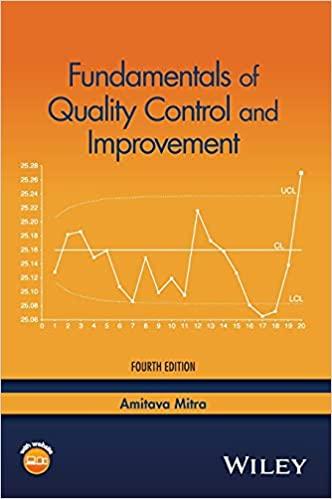Answered step by step
Verified Expert Solution
Question
1 Approved Answer
Read the information in all photos and answer the questions using what you read. 2.3 Students treated as customers Gruber et al. (2010), in their
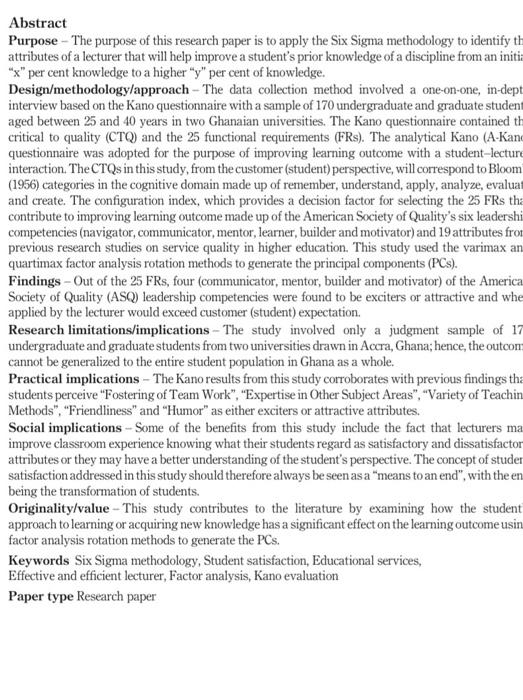
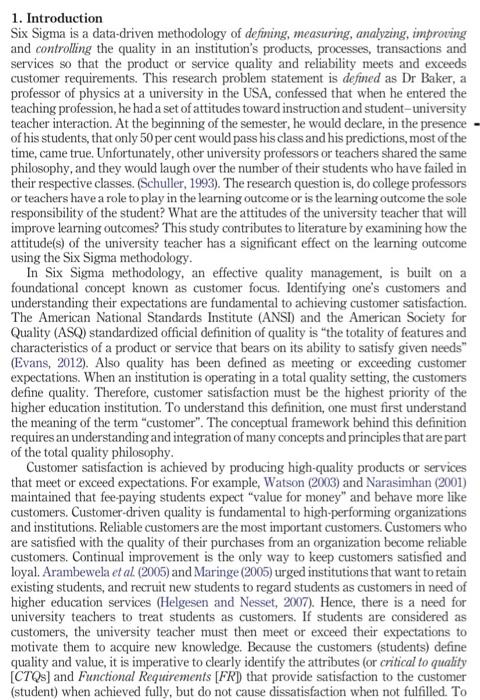
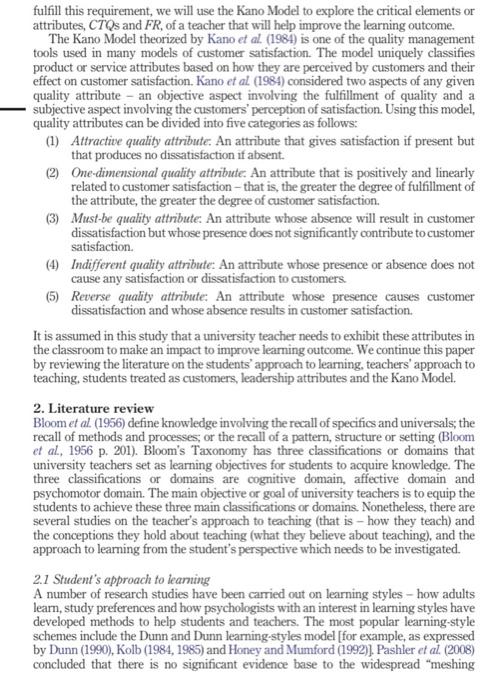
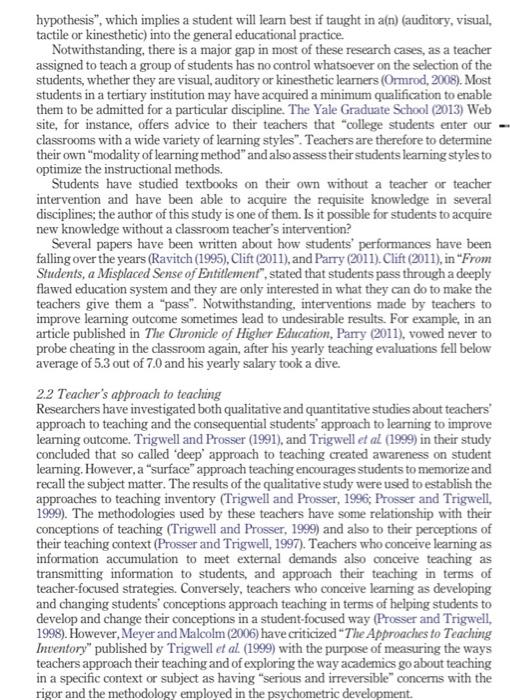
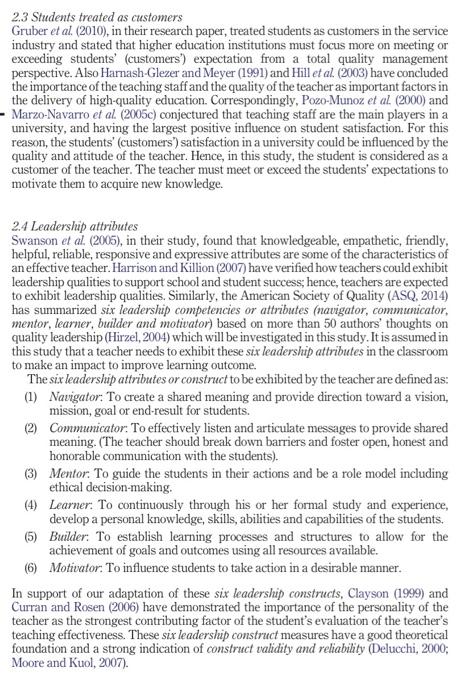

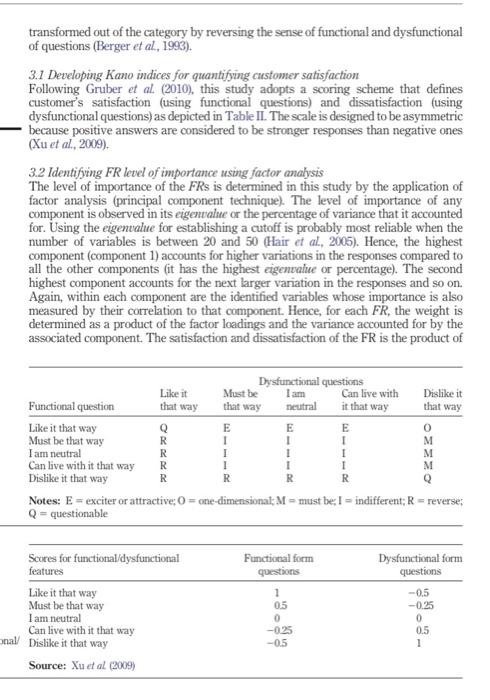
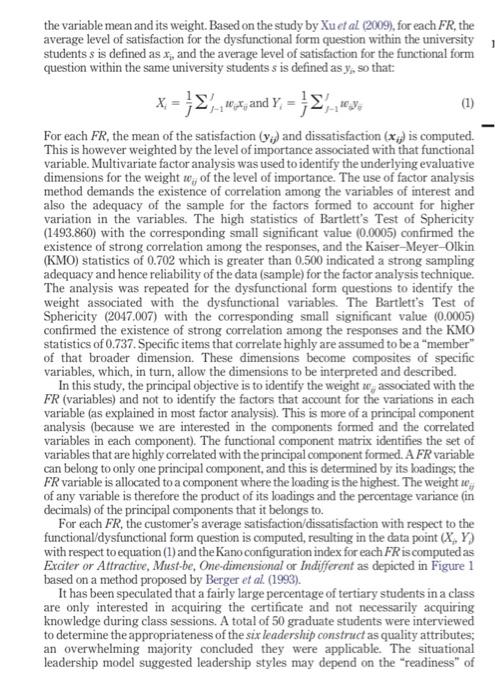
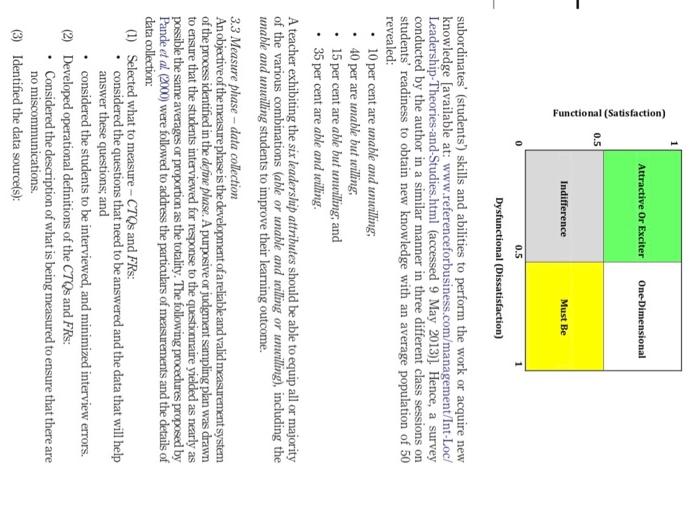
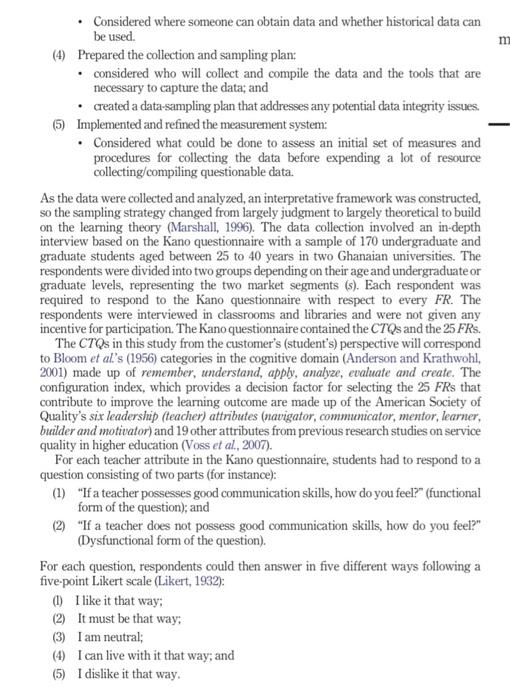
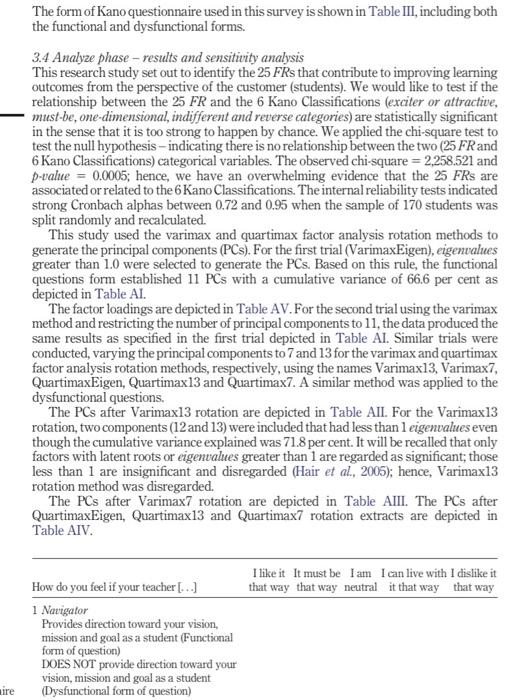
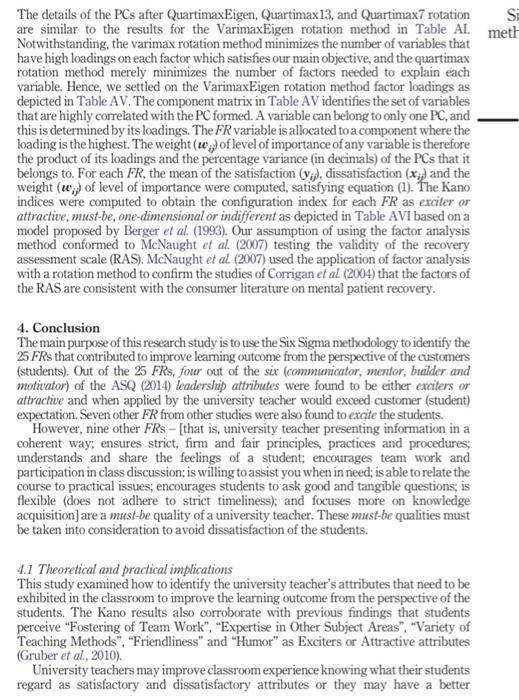
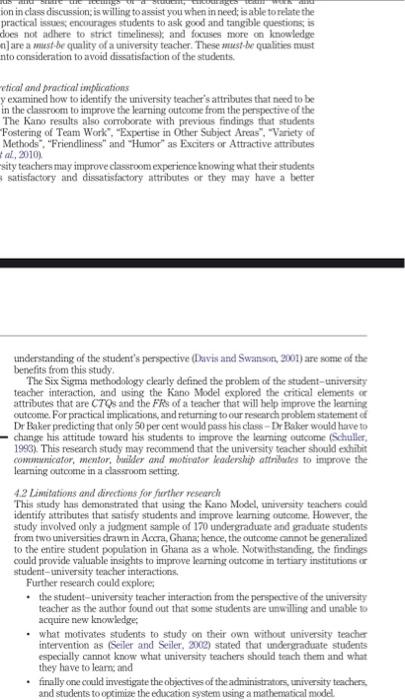
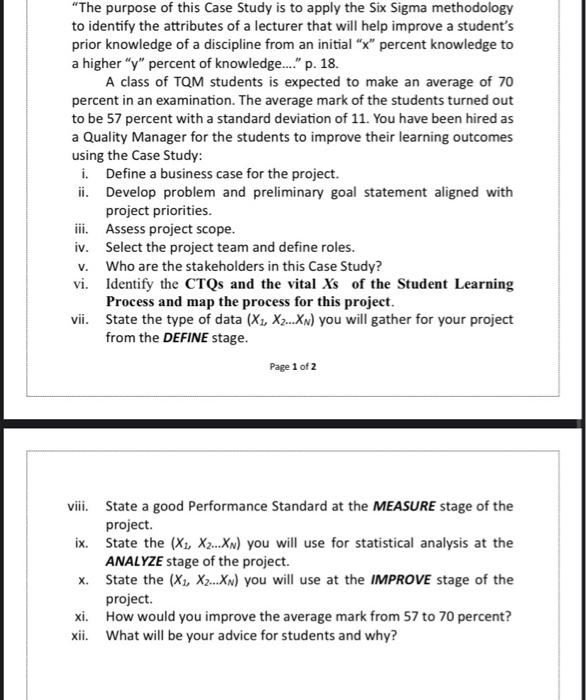
Read the information in all photos and answer the questions using what you read.
2.3 Students treated as customers Gruber et al. (2010), in their research paper, treated students as customers in the service industry and stated that higher education institutions must focus more on meeting or exceeding students' (customers') expectation from a total quality management perspective. Also Harnash-Glezer and Meyer (1991) and Hill et al. (2003) have concluded the importance of the teaching staff and the quality of the teacher as important factors in the delivery of high-quality education. Correspondingly, Pozo-Munoz et al. (2000) and - Marzo-Navarro et al (2005c) conjectured that teaching staff are the main players in a university, and having the largest positive influence on student satisfaction. For this reason, the students' (customers') satisfaction in a university could be influenced by the quality and attitude of the teacher. Hence, in this study, the student is considered as a customer of the teacher. The teacher must meet or exceed the students' expectations to motivate them to acquire new knowledge. 2.4 Leadership attributes Swanson et al. (2005), in their study, found that knowledgeable, empathetic, friendly, helpful, reliable, responsive and expressive attributes are some of the characteristics of an effective teacher. Harrison and Killion (2007) have verified how teachers could exhibit leadership qualities to support school and student success; hence, teachers are expected to exhibit leadership qualities. Similarly, the American Society of Quality (ASQ, 2014) has summarized six leadership competencies or attributes (navigator, communicator, mentor, leamer, builder and motivator) based on more than 50 authors' thoughts on quality leadership (Hirzel, 2004) which will be investigated in this study. It is assumed in this study that a teacher needs to exhibit these six leadership attributes in the classroom to make an impact to improve learning outcome. The six leadership attributes or construct to be exhibited by the teacher are defined as: (1) Navigator: To create a shared meaning and provide direction toward a vision, mission, goal or end-result for students. (2) Communicator: To effectively listen and articulate messages to provide shared meaning. (The teacher should break down barriers and foster open, honest and honorable communication with the students). (3) Mentor: To guide the students in their actions and be a role model including ethical decision-making. (4) Learner: To continuously through his or her formal study and experience, develop a personal knowledge, skills, abilities and capabilities of the students. (5) Builder: To establish learning processes and structures to allow for the achievement of goals and outcomes using all resources available. (6) Motivator: To influence students to take action in a desirable manner. In support of our adaptation of these six leadership constructs, Clayson (1999) and Curran and Rosen (2006) have demonstrated the importance of the personality of the teacher as the strongest contributing factor of the student's evaluation of the teacher's teaching effectiveness. These six leadership construct measures have a good theoretical foundation and a strong indication of construct validity and reliability (Delucchi, 2000; Moore and Kuol, 2007). fulfill this requirement, we will use the Kano Model to explore the critical elements or attributes, CTQ s and FR, of a teacher that will help improve the learning outcome. The Kano Model theorized by Kano et al. (1984) is one of the quality management tools used in many models of customer satisfaction. The model uniquely classifies product or service attributes based on how they are perceived by customers and their effect on customer satisfaction. Kano et al. (1984) considered two aspects of any given quality attribute - an objective aspect involving the fulfillment of quality and a subjective aspect involving the customers' perception of satisfaction. Using this model, quality attributes can be divided into five categories as follows: (1) Attractive quality attribute. An attribute that gives satisfaction if present but that produces no dissatisfaction if absent. (2) One-dimensional quality attribute. An attribute that is positively and linearly related to customer satisfaction - that is, the greater the degree of fulfillment of the attribute, the greater the degree of customer satisfaction. (3) Must-be quality attribute: An attribute whose absence will result in customer dissatisfaction but whose presence does not significantly contribute to customer satisfaction. (4) Indifferent quality attribute: An attribute whose presence or absence does not cause any satisfaction or dissatisfaction to customers. (5) Reverse quality attribute: An attribute whose presence causes customer dissatisfaction and whose absence results in customer satisfaction. It is assumed in this study that a university teacher needs to exhibit these attributes in the classroom to make an impact to improve learning outcome. We continue this paper by reviewing the literature on the students' approach to learning, teachers' approach to teaching, students treated as customers, leadership attributes and the Kano Model. 2. Literature review Bloom et al. (1956) define knowledge involving the recall of specifics and universals; the recall of methods and processes; or the recall of a pattern, structure or setting (Bloom et al., 1956p.201 ). Bloom's Taxonomy has three classifications or domains that university teachers set as learning objectives for students to acquire knowledge. The three classifications or domains are cognitive domain, affective domain and psychomotor domain. The main objective or goal of university teachers is to equip the students to achieve these three main classifications or domains. Nonetheless, there are several studies on the teacher's approach to teaching (that is - how they teach) and the conceptions they hold about teaching (what they believe about teaching), and the approach to learning from the student's perspective which needs to be investigated. 2.1 Student's approach to leaming A number of research studies have been carried out on learning styles - how adults learn, study preferences and how psychologists with an interest in learning styles have developed methods to help students and teachers. The most popular learning-style schemes include the Dunn and Dunn learning-styles model [for example, as expressed by Dunn (1990), Kolb (1984, 1985) and Honey and Mumford (1992)]. Pashler et al. (2008) concluded that there is no significant evidence base to the widespread "meshing subordinates' (students') skills and abilities to perform the work or acquire new knowledge [available at: www.referenceforbusiness.com/management/Int-Loc/ Leadership-Theories-and-Studies.html (accessed 9 May 2013)]. Hence, a survey conducted by the author in a similar manner in three different class sessions on students' readiness to obtain new knowledge with an average population of 50 revealed: - 10 per cent are unable and unvilling; - 40 per are unable but willing, - 15 per cent are able but wnoilling, and - 35 per cent are able and willing. A teacher exhibiting the six leadership attributes should be able to equip all or majority of the various combinations (able or unable and willing or wnoilling), including the unable and unwilling students to improve their learning outcome. 3.3 Measure phase - data collection Anobjective of the measure phase is the development of a reliableand valid measurement system of the process identified in the define pliase. A purposive or judgment sampling plan was drawn to ensure that the students interviewed for response to the questionnaire yielded as nearly as possible the same averages or proportion as the totality. The following procedures proposed by Pande et al (2000) were followed to address the particulars of measurements and the details of data collection: (1) Selected what to measure - CTQs and FRs: - considered the questions that need to be answered and the data that will help answer these questions; and - considered the students to be interviewed, and minimized interview errors. (2) Developed operational definitions of the CTQs and FR: - Considered the description of what is being measured to ensure that there are no miscommunications. (3) Identified the data source(s): hypothesis", which implies a student will learn best if taught in a(n) (auditory, visual, tactile or kinesthetic) into the general educational practice. Notwithstanding, there is a major gap in most of these research cases, as a teacher assigned to teach a group of students has no control whatsoever on the selection of the students, whether they are visual, auditory or kinesthetic learners (Ormrod, 2008). Most students in a tertiary institution may have acquired a minimum qualification to enable them to be admitted for a particular discipline. The Yale Graduate School (2013) Web site, for instance, offers advice to their teachers that "college students enter our classrooms with a wide variety of learning styles". Teachers are therefore to determine their own "modality of learning method" and also assess their students learning styles to optimize the instructional methods. Students have studied textbooks on their own without a teacher or teacher intervention and have been able to acquire the requisite knowledge in several disciplines; the author of this study is one of them. Is it possible for students to acquire new knowledge without a classroom teacher's intervention? Several papers have been written about how students' performances have been falling over the years (Ravitch (1995), Clift (2011), and Parry (2011). Clift (2011), in "From Students, a Misplaced Sense of Entitlement", stated that students pass through a deeply flawed education system and they are only interested in what they can do to make the teachers give them a "pass". Notwithstanding, interventions made by teachers to improve learning outcome sometimes lead to undesirable results. For example, in an article published in The Chronicle of Higher Education, Parry (2011), vowed never to probe cheating in the classroom again, after his yearly teaching evaluations fell below average of 5.3 out of 7.0 and his yearly salary took a dive. 2.2 Teacher's approach to teaching Researchers have investigated both qualitative and quantitative studies about teachers' approach to teaching and the consequential students' approach to learning to improve learning outcome. Trigwell and Prosser (1991), and Trigwell et aL (1999) in their study concluded that so called 'deep' approach to teaching created awareness on student learning. However, a "surface" approach teaching encourages students to memorize and recall the subject matter. The results of the qualitative study were used to establish the approaches to teaching inventory (Trigwell and Prosser, 1996; Prosser and Trigwell, 1999). The methodologies used by these teachers have some relationship with their conceptions of teaching (Trigwell and Prosser, 1999) and also to their perceptions of their teaching context (Prosser and Trigwell, 1997). Teachers who conceive learning as information accumulation to meet external demands also conceive teaching as transmitting information to students, and approach their teaching in terms of teacher-focused strategies. Conversely, teachers who conceive learning as developing and changing students' conceptions approach teaching in terms of helping students to develop and change their conceptions in a student-focused way (Prosser and Trigwell, 1998). However, Meyer and Malcolm (2006) have criticized "The Approaches to Teaching Inventory" published by Trigwell e al. (1999) with the purpose of measuring the ways teachers approach their teaching and of exploring the way academics go about teaching in a specific context or subject as having "serious and irreversible" concems with the rigor and the methodology employed in the psychometric development. To that end, the Kano Model (Kano etal.,1984)wouldbeusedinthisstudytoreveal the preferred six leadership attributes (navigator, communicator, mentor, leamer, builder and motivator) of the teacher that needs to be exhibited in the classroom to improve the learning outcome. 2.5 Six Sigma methodology - the Kano Model The Kano Model is used to identify the critical elements or attributes, CTQs and FRs, of a teacher that will help improve the learning outoome. The traditional Kano Model (Kano et al., 1984) is an approximate estimate of the customer's satisfaction in relation to the service provided or performance level. Hence, it only allows attributes of qualitative assessment of the service provided (Wassenaar et al, 2005). It will be convenient to incorporate quantitative measures to assign some scales in terms of the levels of customer satisfaction or dissatisfaction (Matzler and Hinterhuber, 1998). However, the resulting Kano category is still qualitative in nature, which could not precisely reflect the extent to which the customers are satisfied (Berger et al., 1993). Hence, Xu et al. (2009), in an effort to address the inherent deficiencies of the traditional Kano et al, (1984) method, proposed an analytical Kano (A-Kano) Model with a focus on customer need analysis. The A-Kano Model extends traditional Kano indices, which are quantitative measurements of customer satisfaction derived from Kano questionnaires and surveys. Kano classifiers, which consist of a set of criteria to classify customer CTQs based on the Kano indices. The A-Kano was adopted for the purpose of improving learning outcome with a student-university teacher interaction. However, we do not agree that the importance of the FRs or the leadership attributes should be self-stated. Our contribution to literature is to use the factor analysis method to determine the level of importance instead of the self-stated importance as stated by Xuu et al. (2009). 3. Methodology This study replicates that of Xu et al's (2009) Kano indices model for quantification of customer satisfaction. Let s denote the university students which is made up of J students (respondents), so that s{tjj1,2[]J. The set of FRs is identified as F{fii1,2[]I}. The respondents evaluations are denoted by fi(i1,2[]I) as per the functional and dysfunctional forms of Kano Model questions. For each respondent, tjs(j=1,2[],J), the evaluation fi(i1,2[]I) is represented as eij=(xij,yij,wij), where xij is the score given to an FR for the dysfunctional form question; yij is the score given to an FR for the functional form question; and, for wij, we do not agree that it should be a self-stated importance, which is the respondent's perception or the importance of an FR. However, we assume, in this study, that the level of importance of the FR should be determined by the application of factor analysis (principal component technique). Based on the Kano Model, the FR s of each variable were initially classified (using the functional and dysfunctional form of Kano questions) as exciter or attractive (a), must-be (m), one-dimensional (o) and indifferent (i) as depicted in Table I. For each variable, a contingency output was generated (between functional and dysfunctional questions) and the frequencies of respondents summed according to the classification structure (where the letters represent the Kano customer groups). A Questionable (Q) category will not be included in the averages, and a Reverse (R) category can be Purpose - The purpose of this research paper is to apply the Six Sigma methodology to identify th attributes of a lecturer that will help improve a student's prior knowledge of a discipline from an initi " x " per cent knowledge to a higher " y " per cent of knowledge. Design/methodology/approach - The data collection method involved a one-on-one, in-dept interview based on the Kano questionnaire with a sample of 170 undergraduate and graduate studen aged between 25 and 40 years in two Ghanaian universities. The Kano questionnaire contained th critical to quality (CTQ) and the 25 functional requirements (FRs). The analytical Kano (A-Kan questionnaire was adopted for the purpose of improving learning outcome with a student-lecture interaction. The CTQs in this study, from the customer (student) perspective, will correspond to Bloom (1956) categories in the cognitive domain made up of remember, understand, apply, analyze, evalua and create. The configuration index, which provides a decision factor for selecting the 25 FRs tha contribute to improving learning outcome made up of the American Society of Quality's six leadershi competencies (navigator, communicator, mentor, learner, builder and motivator) and 19 attributes frot previous research studies on service quality in higher education. This study used the varimax an quartimax factor analysis rotation methods to generate the principal components (PCs). Findings - Out of the 25 FRs, four (communicator, mentor, builder and motivator) of the America Society of Quality (ASQ) leadership competencies were found to be exciters or attractive and whe applied by the lecturer would exceed customer (student) expectation. Research limitations/implications - The study involved only a judgment sample of 17 undergraduate and graduate students from two universities drawn in Accra, Ghana; hence, the outcon cannot be generalized to the entire student population in Ghana as a whole. Practical implications - The Kano results from this study corroborates with previous findings tha students perceive "Fostering of Team Work", "Expertise in Other Subject Areas", "Variety of Teachin Methods", "Friendliness" and "Humor" as either exciters or attractive attributes. Social implications - Some of the benefits from this study include the fact that lecturers ma improve classroom experience knowing what their students regard as satisfactory and dissatisfactor attributes or they may have a better understanding of the student's perspective. The concept of studer satisfaction addressed in this study should therefore always be seen as a "means to an end", with the en being the transformation of students. Originality/value - This study contributes to the literature by examining how the student approach to learning or acquiring new knowledge has a significant effect on the learning outcome usin factor analysis rotation methods to generate the PCs. Keywords Six Sigma methodology, Student satisfaction, Educational services, Effective and efficient lecturer, Factor analysis, Kano evaluation Paper type Research paper The form of Kano questionnaire used in this survey is shown in Table III, including both the functional and dysfunctional forms. 3.4 Analyze phase - results and sensitivity analysis This research study set out to identify the 25FR s that contribute to improving learning outcomes from the perspective of the customer (students). We would like to test if the relationship between the 25FR and the 6 Kano Classifications (exciter or attractive, must-be, one-dimensional, indifferent and reverse categories) are statistically significant in the sense that it is too strong to happen by chance. We applied the chi-square test to test the null hypothesis - indicating there is no relationship between the two (25 FR and 6 Kano Classifications) categorical variables. The observed chi-square =2,258.521 and p-value =0.0005; hence, we have an overwhelming evidence that the 25FRs are associated or related to the 6 Kano Classifications. The internal reliability tests indicated strong Cronbach alphas between 0.72 and 0.95 when the sample of 170 students was split randomly and recalculated. This study used the varimax and quartimax factor analysis rotation methods to generate the principal components (PCs). For the first trial (VarimaxEigen), eigenvalues greater than 1.0 were selected to generate the PCs. Based on this rule, the functional questions form established 11PCs with a cumulative variance of 66.6 per cent as depicted in Table AI. The factor loadings are depicted in Table AV. For the second trial using the varimax method and restricting the number of principal components to 11 , the data produced the same results as specified in the first trial depicted in Table AI. Similar trials were conducted, varying the principal components to 7 and 13 for the varimax and quartimax factor analysis rotation methods, respectively, using the names Varimax13, Varimax7, QuartimaxEigen, Quartimax13 and Quartimax7. A similar method was applied to the dysfunctional questions. The PCs after Varimax13 rotation are depicted in Table AII. For the Varimax13 rotation, two components (12 and 13) were included that had less than 1 eigenvalues even though the cumulative variance explained was 71.8 per cent. It will be recalled that only factors with latent roots or eigenvalues greater than 1 are regarded as significant; those less than 1 are insignificant and disregarded (Hair et al., 2005); hence, Varimax13 rotation method was disregarded. The PCs after Varimax7 rotation are depicted in Table AIII. The PC s after QuartimaxEigen, Quartimax13 and Quartimax7 rotation extracts are depicted in Table AIV. ion in class discussion; is willing to assist you when in need; is able to relate the practical issues; encourages students to ask good and tangible questions; is does not adhere to strict timeliness); and focuses more on knowledge a] are a must be quality of a university teacher. These must-be qualities must nto consideration to avoid dissatisfaction of the students. rtical and practical implications y examined how to identify the university teacher's attributes that need to be in the classocm to improve the learning cutcome from the perspective of the The Kano results also corroborate with previous findings that students Fostering of Team Work", "Expertise in Other Subject Areas", "Variety of Methods". "Friendliness" and "Humor" as Exciters or Attractive attributes at, 2010 sity teachers may improve classroom experience knowing what their students satisfactory and diseatisfactory attributes of they may have a better undentanding of the student's perspective (Davis and Swanson, 2001) are some of the benefits from this study. The Six Sigma methodology clearly defined the problem of the student-university teacher interaction, and asing the Kano Model explored the critical elements of attributes that are CTQs and the FR of a teacher that will belp improve the learning outcome. For practical implications, and returning to our rescarch problem statement of Dr Baker predicting that only 50 per cent would pass his class-Dr Baloer would have to change has attitude toward his students to improve the lesming outcome (Schuller, 1993). This research study may recommend that the university teacher should exhibit commanicator, mentor, benider and motinator kedership attnibutes to improve the learning outontne in a classroom setting. 4.2 Linitations and circtions for further research This study has demonstrated that using the Kano Model, univenity teachers could identify attributes that satisfy students and impeove learning outcome. However, the study involved only a judgment sample of 170 tundergraduate and graduate students from two universities drawn in Accra, Ghana, bence, the outcome cannot be generalized to the entire student population in Ghana as a whole. Notwithstanding, the findings could prowide valuable insights to improve leaming outcome in tertiary institutions or student-university teacher interactions, Further research could explore, - the student-university teacher interaction from the perspective of the university teacher as the author found out that some students are unwilling and unsble to acquire new knowledge; - what motivates students to study on their own without university teacher intervention as (Seler and Seiler, 300 ) stated that underyeduate students especially cannot know what university teachers should teach them and what they have to leam and - finally one could imvestigate the objectives of the administratnes, university teachers. 1. Introduction Six Sigma is a data-driven methodology of defuning, measuring, analyzing, improving and controlling the quality in an institution's products, processes, transactions and services so that the product or service quality and reliability meets and exceeds customer requirements. This research problem statement is defined as Dr Baker, a professor of physics at a university in the USA, confessed that when he entered the teaching profession, he had a set of attitudes toward instruction and student-university teacher interaction. At the beginning of the semester, he would declare, in the presence of his students, that only 50 per cent would pass his class and his predictions, most of the time, came true. Unfortunately, other university professors or teachers shared the same philosophy, and they would laugh over the number of their students who have failed in their respective classes. (Schuller, 1993). The research question is, do college professors or teachers have a role to play in the learning outcome or is the learning outcome the sole responsibility of the student? What are the attitudes of the university teacher that will improve learning outcomes? This study contributes to literature by examining how the attitude(s) of the university teacher has a significant effect on the learning outcome using the Six Sigma methodology. In Six Sigma methodology, an effective quality management, is built on a foundational concept known as customer focus. Identifying one's customers and understanding their expectations are fundamental to achieving customer satisfaction. The American National Standards Institute (ANSI) and the American Society for Quality (ASQ) standardized official definition of quality is "the totality of features and characteristics of a product or service that bears on its ability to satisfy given needs" (Evans, 2012). Also quality has been defined as meeting or exceeding customer expectations. When an institution is operating in a total quality setting, the customers define quality. Therefore, customer satisfaction must be the highest priority of the higher education institution. To understand this definition, one must first understand the meaning of the term "customer". The conceptual framework behind this definition requires an understanding and integration of many concepts and principles that are part of the total quality philosophy. Customer satisfaction is achieved by producing high-quality products or services that meet or exceed expectations. For example, Watson (2003) and Narasimhan (2001) maintained that fee-paying students expect "value for money" and behave more like customers. Customer-driven quality is fundamental to high-performing organizations and institutions. Reliable customers are the most important customers. Customers who are satisfied with the quality of their purchases from an organization become reliable customers. Continual improvement is the only way to keep customers satisfied and loyal. Arambewela et al. (2005) and Maringe (2005) urged institutions that want to retain existing students, and recruit new students to regard students as customers in need of higher education services (Helgesen and Nesset, 2007). Hence, there is a need for university teachers to treat students as customers. If students are considered as customers, the university teacher must then meet or exceed their expectations to motivate them to acquire new knowledge. Because the customers (students) define quality and value, it is imperative to clearly identify the attributes (or critical to quality [CTQs] and Functional Requirements [FR] that provide satisfaction to the customer (student) when achieved fully, but do not cause dissatisfaction when not fulfilled. To 3.2 Identifying FR level of importance using factor analysis The level of importance of the FRs is determined in this study by the application of factor analysis (principal component technique). The level of importance of any component is observed in its eigenvalue or the percentage of variance that it accounted for. Using the eigenvalue for establishing a cutoff is probably most reliable when the number of variables is between 20 and 50 (Hair d al, 2005). Hence, the highest component (component 1) accounts for higher variations in the responses compared to all the other components (it has the highest eigenvalue or percentage). The second highest component accounts for the next larger variation in the responses and so on. Again, within each component are the identified variables whose importance is also measured by their correlation to that component. Hence, for each FR, the weight is determined as a product of the factor loadings and the variance accounted for by the associated component. The satisfaction and dissatisfaction of the FR is the product of the variable mean and its weight. Based on the study by Xuct al (2009), for each FR, the average level of satisfaction for the dysfunctional form question within the university students s is defined as xi, and the average level of satisfaction for the functional form question within the same university students s is defined as yi, so that: Xi=J1j1wixijandYi=J1j1wiy For each FR, the mean of the satisfaction (yij) and dissatisfaction (xij) is computed. This is however weighted by the level of importance associated with that functional variable. Multivariate factor analysis was used to identify the underlying evaluative dimensions for the weight wij of the level of importance. The use of factor analysis method demands the existence of correlation among the variables of interest and also the adequacy of the sample for the factors formed to account for higher variation in the variables. The high statistics of Bartlett's Test of Sphericity (1493.860) with the corresponding small significant value (0.0005) confirmed the existence of strong correlation among the responses, and the Kaiser-Meyer-Olkin (KMO) statistics of 0.702 which is greater than 0.500 indicated a strong sampling adequacy and hence reliability of the data (sample) for the factor analysis technique. The analysis was repeated for the dysfunctional form questions to identify the weight associated with the dysfunctional variables. The Bartlett's Test of Sphericity (2047.007) with the corresponding small significant value (0.0005) confirmed the existence of strong correlation among the responses and the KMO statistics of 0.737 . Specific items that correlate highly are assumed to be a "member" of that broader dimension. These dimensions become composites of specific variables, which, in turn, allow the dimensions to be interpreted and described. In this study, the principal objective is to identify the weight wj associated with the FR (variables) and not to identify the factors that account for the variations in each variable (as explained in most factor analysis). This is more of a principal component analysis (because we are interested in the components formed and the correlated variables in each component). The functional component matrix identifies the set of variables that are highly correlated with the principal component formed. A FR variable can belong to only one principal component, and this is determined by its loadings, the FR variable is allocated to a component where the loading is the highest. The weight wif of any variable is therefore the product of its loadings and the percentage variance (in decimals) of the principal components that it belongs to. For each FR, the customer's average satisfaction/dissatisfaction with respect to the functional/dysfunctional form question is computed, resulting in the data point (Xi,Yp) with respect to equation (1) and the Kano configuration index for each FR is computed as Exciter or Attractive, Must-be, One-dimensional or Indifferent as depicted in Figure 1 based on a method proposed by Berger et al. (1993). It has been speculated that a fairly large percentage of tertiary students in a class are only interested in acquiring the certificate and not necessarily acquiring knowledge during class sessions. A total of 50 graduate students were interviewed to determine the appropriateness of the six leadership construct as quality attributes; an overwhelming majority concluded they were applicable. The situational leadership model suggested leadership styles may depend on the "readiness" of The details of the PCs after QuartimaxEigen, Quartimax13, and Quartimax7 rotation are similar to the results for the VarimaxEigen rotation method in Table AI. Notwithstanding, the varimax rotation method minimizes the number of variables that have high loadings on each factor which satisfies our main objective, and the quartimax rotation method merely minimizes the number of factors needed to explain each variable. Hence, we settled on the VarimaxEigen rotation method factor loadings as depicted in Table AV. The component matrix in Table AV identifies the set of variables that are highly correlated with the PC formed. A variable can belong to only one PC, and this is determined by its loadings. The FR variable is allocated to a component where the loading is the highest. The weight (wij) of level of importance of any variable is therefore the product of its loadings and the percentage variance (in decimals) of the PCs that it belongs to. For each FR, the mean of the satisfaction (yij), dissatisfaction (xij) and the weight (wij) of level of importance were computed, satisfying equation (1). The Kano indices were computed to obtain the configuration index for each FR as exciter or attractive, must-be, one-dimensional or indifferent as depicted in Table AVI based on a model proposed by Berger et al. (1993). Our assumption of using the factor analysis method conformed to McNaught et al. (2007) testing the validity of the recovery assessment scale (RAS). McNaught et al. (2007) used the application of factor analysis with a rotation method to confirm the studies of Corrigan et al. (2004) that the factors of the RAS are consistent with the consumer literature on mental patient recovery. 4. Conclusion The main purpose of this research study is to use the Six Sigma methodology to identify the 25FR s that contributed to improve learning outcome from the perspective of the customers (students). Out of the 25FR s, four out of the six (communicator, mentor, bualder and motivator) of the ASQ (2014) leadership attributes were found to be either exciters or attractive and when applied by the university teacher would exceed customer (student) expectation. Seven other FR from other studies were also found to excite the students. However, nine other FRs - [that is, university teacher presenting information in a coherent way; ensures strict, firm and fair principles, practices and procedures; understands and share the feelings of a student; encourages team work and participation in class discussion; is willing to assist you when in need; is able to relate the course to practical issues; encourages students to ask good and tangible questions; is flexible (does not adhere to strict timeliness); and focuses more on knowledge acquisition] are a must-be quality of a university teacher. These must-be qualities must be taken into consideration to avoid dissatisfaction of the students. 4.1 Theoretical and practical implications This study examined how to identify the university teacher's attributes that need to be exhibited in the classroom to improve the learning outcome from the perspective of the students. The Kano results also corroborate with previous findings that students perceive "Fostering of Team Work", "Expertise in Other Subject Areas", "Variety of Teaching Methods", "Friendliness" and "Humor" as Exciters or Attractive attributes (Gruber et al., 2010). University teachers may improve classroom experience knowing what their students regard as satisfactory and dissatisfactory attributes or they may have a better (4) Prepared the collection and sampling plan: - considered who will collect and compile the data and the tools that are necessary to capture the data; and - created a data-sampling plan that addresses any potential data integrity issues. (5) Implemented and refined the measurement system: - Considered what could be done to assess an initial set of measures and procedures for collecting the data before expending a lot of resource collecting/compiling questionable data. As the data were collected and analyzed, an interpretative framework was constructed, so the sampling strategy changed from largely judgment to largely theoretical to build on the learning theory (Marshall, 1996). The data collection involved an in-depth interview based on the Kano questionnaire with a sample of 170 undergraduate and graduate students aged between 25 to 40 years in two Ghanaian universities. The respondents were divided into two groups depending on their age and undergraduate or graduate levels, representing the two market segments (s). Each respondent was required to respond to the Kano questionnaire with respect to every FR. The respondents were interviewed in classrooms and libraries and were not given any incentive for participation. The Kano questionnaire contained the CTQs and the 25FRs. The CTQs in this study from the customer's (student's) perspective will correspond to Bloom et al's (1956) categories in the cognitive domain (Anderson and Krathwohl, 2001) made up of remember, understand, apply, analyze, evaluate and create. The configuration index, which provides a decision factor for selecting the 25FR that contribute to improve the learning outcome are made up of the American Society of Quality's six leadership (teacher) attributes (navigator, communicator, mentor, learner, builder and motivator) and 19 other attributes from previous research studies on service quality in higher education (Voss et al., 2007). For each teacher attribute in the Kano questionnaire, students had to respond to a question consisting of two parts (for instance): (1) "If a teacher possesses good communication skills, how do you feel?" (functional form of the question); and (2) "If a teacher does not possess good communication skills, how do you feel?" (Dysfunctional form of the question). For each question, respondents could then answer in five different ways following a five-point Likert scale (Likert, 1932): (I) I like it that way; (2) It must be that way; (3) I am neutral; (4) I can live with it that way; and (5) I dislike it that way. "The purpose of this Case Study is to apply the Six Sigma methodology to identify the attributes of a lecturer that will help improve a student's prior knowledge of a discipline from an initial " x " percent knowledge to a higher " y " percent of knowledge...." p. 18. A class of TQM students is expected to make an average of 70 percent in an examination. The average mark of the students turned out to be 57 percent with a standard deviation of 11. You have been hired as a Quality Manager for the students to improve their learning outcomes using the Case Study: i. Define a business case for the project. ii. Develop problem and preliminary goal statement aligned with project priorities. iii. Assess project scope. iv. Select the project team and define roles. v. Who are the stakeholders in this Case Study? vi. Identify the CTQs and the vital Xs of the Student Learning Process and map the process for this project. vii. State the type of data (X1,X2XN) you will gather for your project from the DEFINE stage. Page 1 of 2 viii. State a good Performance Standard at the MEASURE stage of the project. ix. State the (X1,X2XN) you will use for statistical analysis at the ANALYZE stage of the project. x. State the (X1,X2XN) you will use at the IMPROVE stage of the project. xi. How would you improve the average mark from 57 to 70 percent? xii. What will be your advice for students and why Step by Step Solution
There are 3 Steps involved in it
Step: 1

Get Instant Access to Expert-Tailored Solutions
See step-by-step solutions with expert insights and AI powered tools for academic success
Step: 2

Step: 3

Ace Your Homework with AI
Get the answers you need in no time with our AI-driven, step-by-step assistance
Get Started


